BMP3004: Exploring Functional Areas and Their Importance in Work
VerifiedAdded on 2021/03/08
|7
|2834
|322
Report
AI Summary
This report, based on the provided assignment solution, delves into the diverse functional areas within an organization, encompassing administration, customer service, distribution, finance, human resources, ICT, marketing, sales, and production. It highlights the significance of each area in ensuring operational efficiency, achieving organizational goals, and meeting customer expectations. The report discusses the specific tasks and responsibilities associated with each function, such as managing finances, recruiting and training employees, promoting products, and ensuring timely delivery. The report emphasizes the interdependencies between these functional areas and their collective contribution to the overall success of a business, providing a comprehensive overview of their roles in the modern workplace.
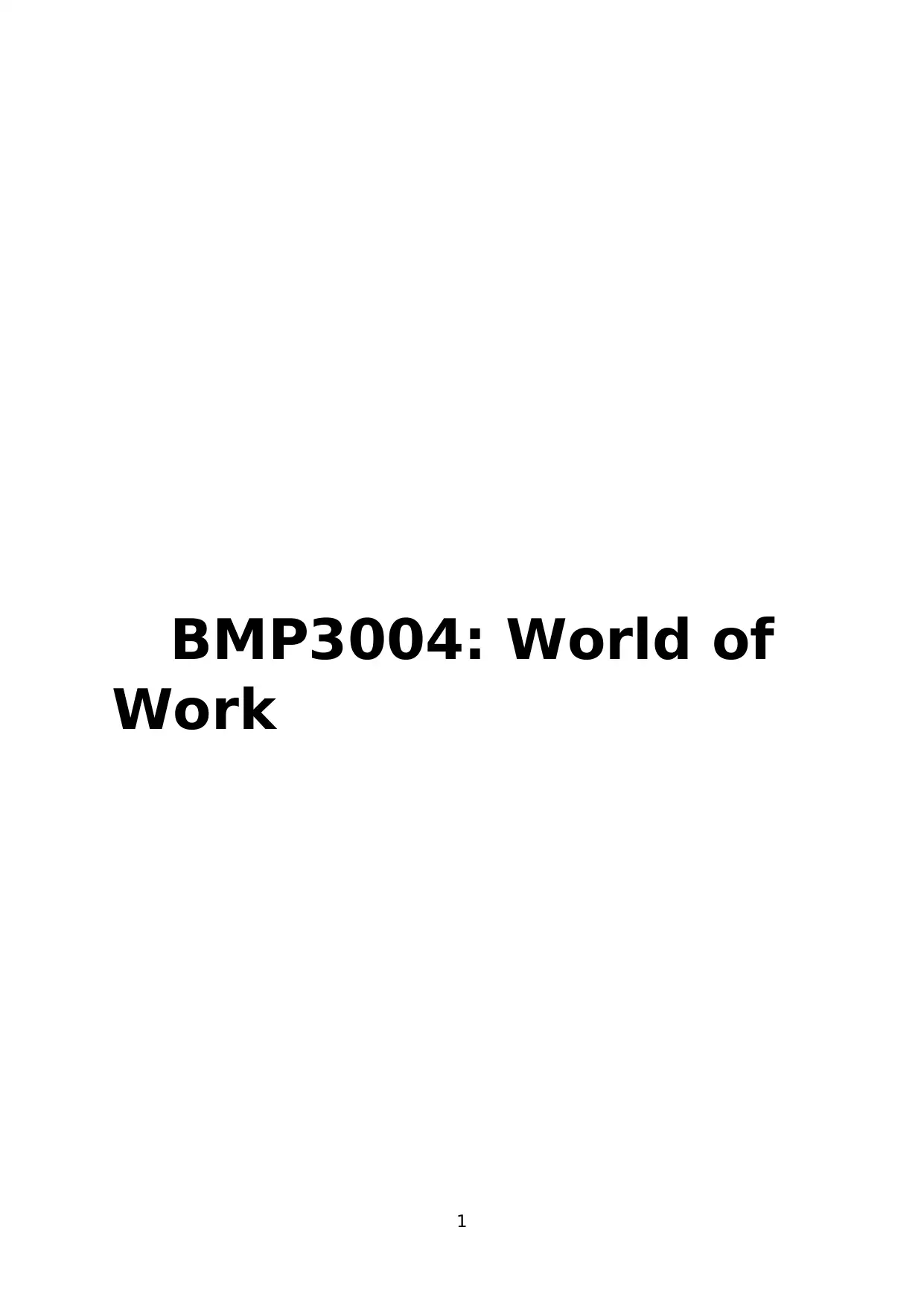
BMP3004: World of
Work
1
Work
1
Paraphrase This Document
Need a fresh take? Get an instant paraphrase of this document with our AI Paraphraser
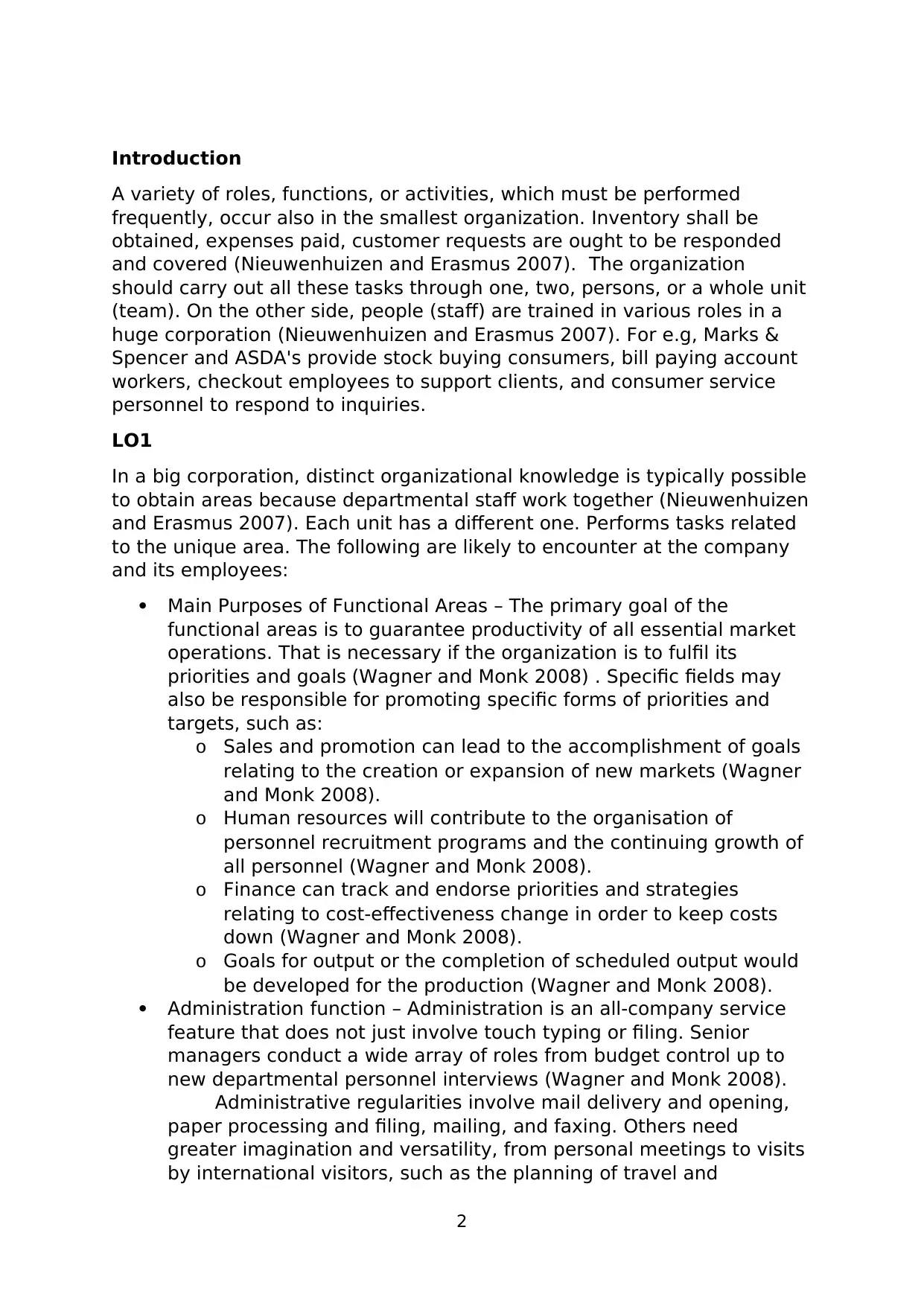
Introduction
A variety of roles, functions, or activities, which must be performed
frequently, occur also in the smallest organization. Inventory shall be
obtained, expenses paid, customer requests are ought to be responded
and covered (Nieuwenhuizen and Erasmus 2007). The organization
should carry out all these tasks through one, two, persons, or a whole unit
(team). On the other side, people (staff) are trained in various roles in a
huge corporation (Nieuwenhuizen and Erasmus 2007). For e.g, Marks &
Spencer and ASDA's provide stock buying consumers, bill paying account
workers, checkout employees to support clients, and consumer service
personnel to respond to inquiries.
LO1
In a big corporation, distinct organizational knowledge is typically possible
to obtain areas because departmental staff work together (Nieuwenhuizen
and Erasmus 2007). Each unit has a different one. Performs tasks related
to the unique area. The following are likely to encounter at the company
and its employees:
Main Purposes of Functional Areas – The primary goal of the
functional areas is to guarantee productivity of all essential market
operations. That is necessary if the organization is to fulfil its
priorities and goals (Wagner and Monk 2008) . Specific fields may
also be responsible for promoting specific forms of priorities and
targets, such as:
o Sales and promotion can lead to the accomplishment of goals
relating to the creation or expansion of new markets (Wagner
and Monk 2008).
o Human resources will contribute to the organisation of
personnel recruitment programs and the continuing growth of
all personnel (Wagner and Monk 2008).
o Finance can track and endorse priorities and strategies
relating to cost-effectiveness change in order to keep costs
down (Wagner and Monk 2008).
o Goals for output or the completion of scheduled output would
be developed for the production (Wagner and Monk 2008).
Administration function – Administration is an all-company service
feature that does not just involve touch typing or filing. Senior
managers conduct a wide array of roles from budget control up to
new departmental personnel interviews (Wagner and Monk 2008).
Administrative regularities involve mail delivery and opening,
paper processing and filing, mailing, and faxing. Others need
greater imagination and versatility, from personal meetings to visits
by international visitors, such as the planning of travel and
2
A variety of roles, functions, or activities, which must be performed
frequently, occur also in the smallest organization. Inventory shall be
obtained, expenses paid, customer requests are ought to be responded
and covered (Nieuwenhuizen and Erasmus 2007). The organization
should carry out all these tasks through one, two, persons, or a whole unit
(team). On the other side, people (staff) are trained in various roles in a
huge corporation (Nieuwenhuizen and Erasmus 2007). For e.g, Marks &
Spencer and ASDA's provide stock buying consumers, bill paying account
workers, checkout employees to support clients, and consumer service
personnel to respond to inquiries.
LO1
In a big corporation, distinct organizational knowledge is typically possible
to obtain areas because departmental staff work together (Nieuwenhuizen
and Erasmus 2007). Each unit has a different one. Performs tasks related
to the unique area. The following are likely to encounter at the company
and its employees:
Main Purposes of Functional Areas – The primary goal of the
functional areas is to guarantee productivity of all essential market
operations. That is necessary if the organization is to fulfil its
priorities and goals (Wagner and Monk 2008) . Specific fields may
also be responsible for promoting specific forms of priorities and
targets, such as:
o Sales and promotion can lead to the accomplishment of goals
relating to the creation or expansion of new markets (Wagner
and Monk 2008).
o Human resources will contribute to the organisation of
personnel recruitment programs and the continuing growth of
all personnel (Wagner and Monk 2008).
o Finance can track and endorse priorities and strategies
relating to cost-effectiveness change in order to keep costs
down (Wagner and Monk 2008).
o Goals for output or the completion of scheduled output would
be developed for the production (Wagner and Monk 2008).
Administration function – Administration is an all-company service
feature that does not just involve touch typing or filing. Senior
managers conduct a wide array of roles from budget control up to
new departmental personnel interviews (Wagner and Monk 2008).
Administrative regularities involve mail delivery and opening,
paper processing and filing, mailing, and faxing. Others need
greater imagination and versatility, from personal meetings to visits
by international visitors, such as the planning of travel and
2
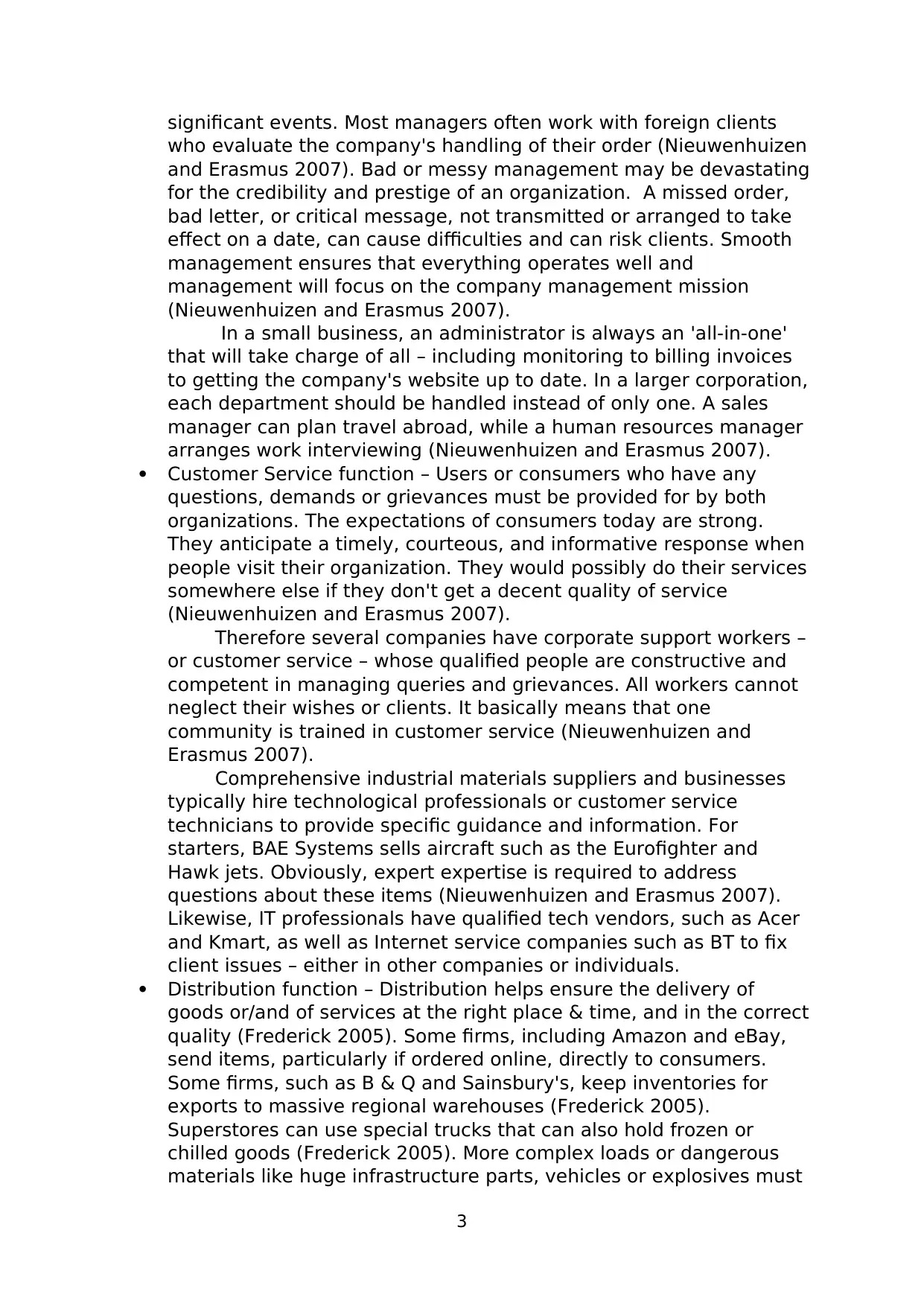
significant events. Most managers often work with foreign clients
who evaluate the company's handling of their order (Nieuwenhuizen
and Erasmus 2007). Bad or messy management may be devastating
for the credibility and prestige of an organization. A missed order,
bad letter, or critical message, not transmitted or arranged to take
effect on a date, can cause difficulties and can risk clients. Smooth
management ensures that everything operates well and
management will focus on the company management mission
(Nieuwenhuizen and Erasmus 2007).
In a small business, an administrator is always an 'all-in-one'
that will take charge of all – including monitoring to billing invoices
to getting the company's website up to date. In a larger corporation,
each department should be handled instead of only one. A sales
manager can plan travel abroad, while a human resources manager
arranges work interviewing (Nieuwenhuizen and Erasmus 2007).
Customer Service function – Users or consumers who have any
questions, demands or grievances must be provided for by both
organizations. The expectations of consumers today are strong.
They anticipate a timely, courteous, and informative response when
people visit their organization. They would possibly do their services
somewhere else if they don't get a decent quality of service
(Nieuwenhuizen and Erasmus 2007).
Therefore several companies have corporate support workers –
or customer service – whose qualified people are constructive and
competent in managing queries and grievances. All workers cannot
neglect their wishes or clients. It basically means that one
community is trained in customer service (Nieuwenhuizen and
Erasmus 2007).
Comprehensive industrial materials suppliers and businesses
typically hire technological professionals or customer service
technicians to provide specific guidance and information. For
starters, BAE Systems sells aircraft such as the Eurofighter and
Hawk jets. Obviously, expert expertise is required to address
questions about these items (Nieuwenhuizen and Erasmus 2007).
Likewise, IT professionals have qualified tech vendors, such as Acer
and Kmart, as well as Internet service companies such as BT to fix
client issues – either in other companies or individuals.
Distribution function – Distribution helps ensure the delivery of
goods or/and of services at the right place & time, and in the correct
quality (Frederick 2005). Some firms, including Amazon and eBay,
send items, particularly if ordered online, directly to consumers.
Some firms, such as B & Q and Sainsbury's, keep inventories for
exports to massive regional warehouses (Frederick 2005).
Superstores can use special trucks that can also hold frozen or
chilled goods (Frederick 2005). More complex loads or dangerous
materials like huge infrastructure parts, vehicles or explosives must
3
who evaluate the company's handling of their order (Nieuwenhuizen
and Erasmus 2007). Bad or messy management may be devastating
for the credibility and prestige of an organization. A missed order,
bad letter, or critical message, not transmitted or arranged to take
effect on a date, can cause difficulties and can risk clients. Smooth
management ensures that everything operates well and
management will focus on the company management mission
(Nieuwenhuizen and Erasmus 2007).
In a small business, an administrator is always an 'all-in-one'
that will take charge of all – including monitoring to billing invoices
to getting the company's website up to date. In a larger corporation,
each department should be handled instead of only one. A sales
manager can plan travel abroad, while a human resources manager
arranges work interviewing (Nieuwenhuizen and Erasmus 2007).
Customer Service function – Users or consumers who have any
questions, demands or grievances must be provided for by both
organizations. The expectations of consumers today are strong.
They anticipate a timely, courteous, and informative response when
people visit their organization. They would possibly do their services
somewhere else if they don't get a decent quality of service
(Nieuwenhuizen and Erasmus 2007).
Therefore several companies have corporate support workers –
or customer service – whose qualified people are constructive and
competent in managing queries and grievances. All workers cannot
neglect their wishes or clients. It basically means that one
community is trained in customer service (Nieuwenhuizen and
Erasmus 2007).
Comprehensive industrial materials suppliers and businesses
typically hire technological professionals or customer service
technicians to provide specific guidance and information. For
starters, BAE Systems sells aircraft such as the Eurofighter and
Hawk jets. Obviously, expert expertise is required to address
questions about these items (Nieuwenhuizen and Erasmus 2007).
Likewise, IT professionals have qualified tech vendors, such as Acer
and Kmart, as well as Internet service companies such as BT to fix
client issues – either in other companies or individuals.
Distribution function – Distribution helps ensure the delivery of
goods or/and of services at the right place & time, and in the correct
quality (Frederick 2005). Some firms, including Amazon and eBay,
send items, particularly if ordered online, directly to consumers.
Some firms, such as B & Q and Sainsbury's, keep inventories for
exports to massive regional warehouses (Frederick 2005).
Superstores can use special trucks that can also hold frozen or
chilled goods (Frederick 2005). More complex loads or dangerous
materials like huge infrastructure parts, vehicles or explosives must
3
⊘ This is a preview!⊘
Do you want full access?
Subscribe today to unlock all pages.

Trusted by 1+ million students worldwide
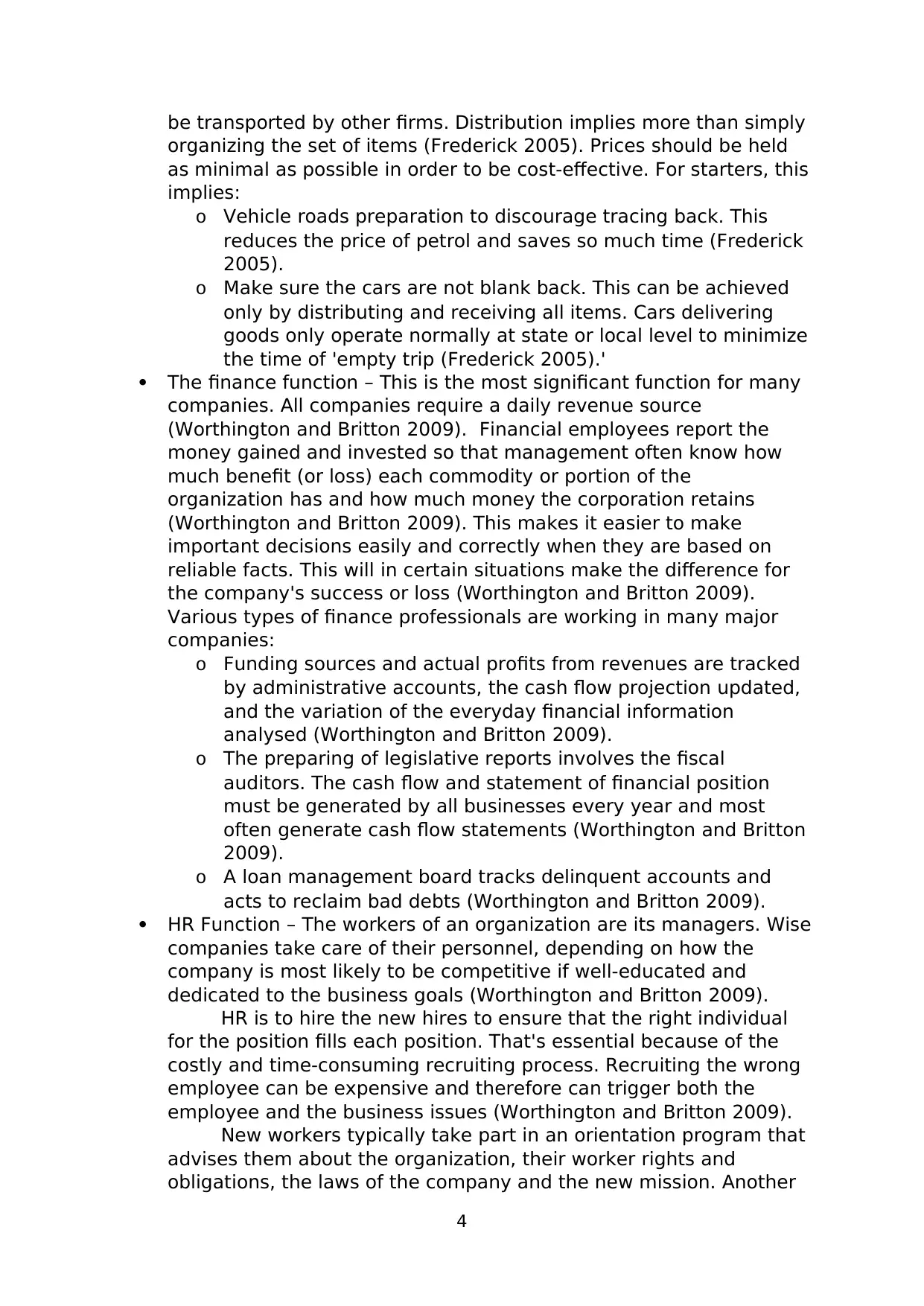
be transported by other firms. Distribution implies more than simply
organizing the set of items (Frederick 2005). Prices should be held
as minimal as possible in order to be cost-effective. For starters, this
implies:
o Vehicle roads preparation to discourage tracing back. This
reduces the price of petrol and saves so much time (Frederick
2005).
o Make sure the cars are not blank back. This can be achieved
only by distributing and receiving all items. Cars delivering
goods only operate normally at state or local level to minimize
the time of 'empty trip (Frederick 2005).'
The finance function – This is the most significant function for many
companies. All companies require a daily revenue source
(Worthington and Britton 2009). Financial employees report the
money gained and invested so that management often know how
much benefit (or loss) each commodity or portion of the
organization has and how much money the corporation retains
(Worthington and Britton 2009). This makes it easier to make
important decisions easily and correctly when they are based on
reliable facts. This will in certain situations make the difference for
the company's success or loss (Worthington and Britton 2009).
Various types of finance professionals are working in many major
companies:
o Funding sources and actual profits from revenues are tracked
by administrative accounts, the cash flow projection updated,
and the variation of the everyday financial information
analysed (Worthington and Britton 2009).
o The preparing of legislative reports involves the fiscal
auditors. The cash flow and statement of financial position
must be generated by all businesses every year and most
often generate cash flow statements (Worthington and Britton
2009).
o A loan management board tracks delinquent accounts and
acts to reclaim bad debts (Worthington and Britton 2009).
HR Function – The workers of an organization are its managers. Wise
companies take care of their personnel, depending on how the
company is most likely to be competitive if well-educated and
dedicated to the business goals (Worthington and Britton 2009).
HR is to hire the new hires to ensure that the right individual
for the position fills each position. That's essential because of the
costly and time-consuming recruiting process. Recruiting the wrong
employee can be expensive and therefore can trigger both the
employee and the business issues (Worthington and Britton 2009).
New workers typically take part in an orientation program that
advises them about the organization, their worker rights and
obligations, the laws of the company and the new mission. Another
4
organizing the set of items (Frederick 2005). Prices should be held
as minimal as possible in order to be cost-effective. For starters, this
implies:
o Vehicle roads preparation to discourage tracing back. This
reduces the price of petrol and saves so much time (Frederick
2005).
o Make sure the cars are not blank back. This can be achieved
only by distributing and receiving all items. Cars delivering
goods only operate normally at state or local level to minimize
the time of 'empty trip (Frederick 2005).'
The finance function – This is the most significant function for many
companies. All companies require a daily revenue source
(Worthington and Britton 2009). Financial employees report the
money gained and invested so that management often know how
much benefit (or loss) each commodity or portion of the
organization has and how much money the corporation retains
(Worthington and Britton 2009). This makes it easier to make
important decisions easily and correctly when they are based on
reliable facts. This will in certain situations make the difference for
the company's success or loss (Worthington and Britton 2009).
Various types of finance professionals are working in many major
companies:
o Funding sources and actual profits from revenues are tracked
by administrative accounts, the cash flow projection updated,
and the variation of the everyday financial information
analysed (Worthington and Britton 2009).
o The preparing of legislative reports involves the fiscal
auditors. The cash flow and statement of financial position
must be generated by all businesses every year and most
often generate cash flow statements (Worthington and Britton
2009).
o A loan management board tracks delinquent accounts and
acts to reclaim bad debts (Worthington and Britton 2009).
HR Function – The workers of an organization are its managers. Wise
companies take care of their personnel, depending on how the
company is most likely to be competitive if well-educated and
dedicated to the business goals (Worthington and Britton 2009).
HR is to hire the new hires to ensure that the right individual
for the position fills each position. That's essential because of the
costly and time-consuming recruiting process. Recruiting the wrong
employee can be expensive and therefore can trigger both the
employee and the business issues (Worthington and Britton 2009).
New workers typically take part in an orientation program that
advises them about the organization, their worker rights and
obligations, the laws of the company and the new mission. Another
4
Paraphrase This Document
Need a fresh take? Get an instant paraphrase of this document with our AI Paraphraser
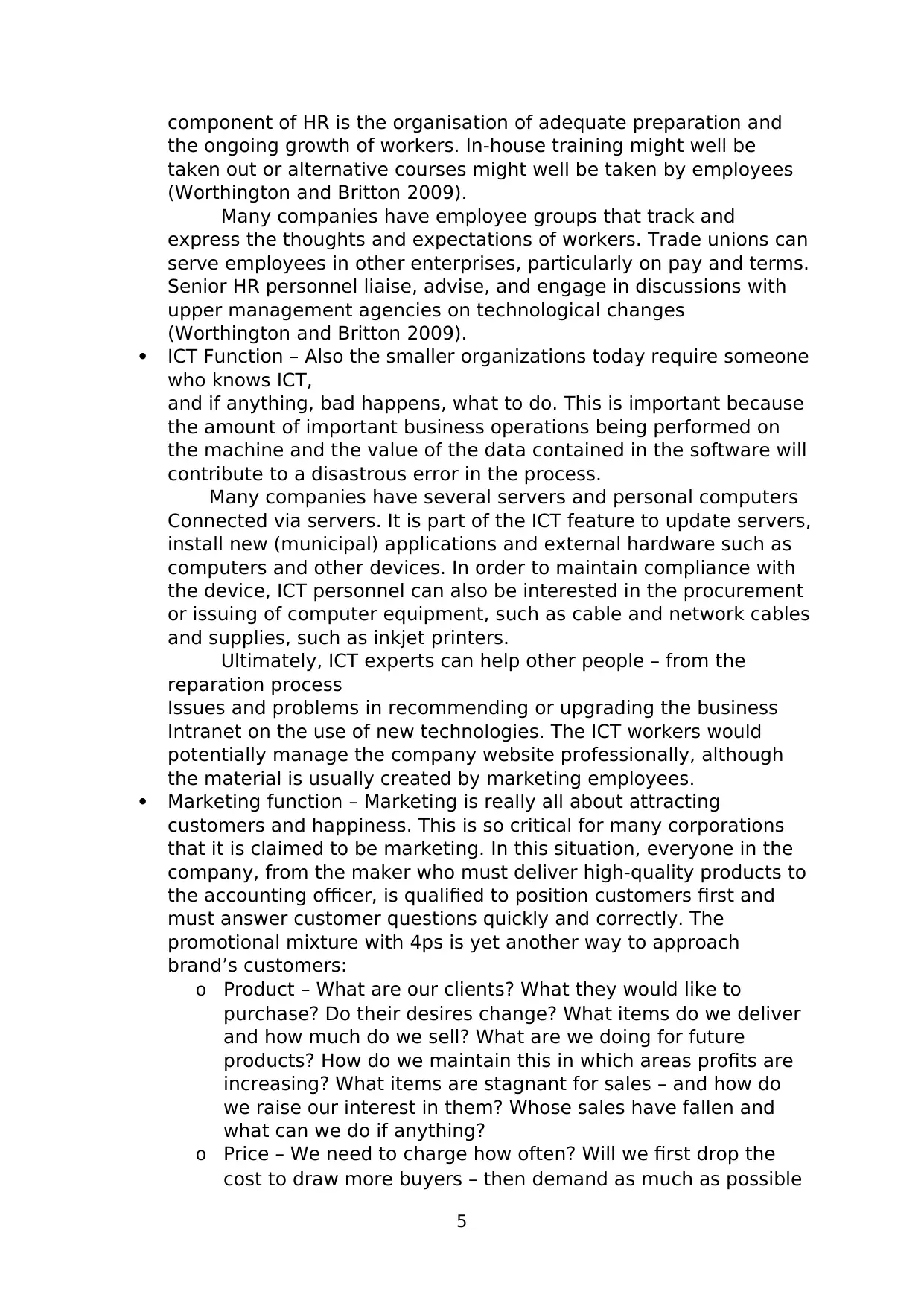
component of HR is the organisation of adequate preparation and
the ongoing growth of workers. In-house training might well be
taken out or alternative courses might well be taken by employees
(Worthington and Britton 2009).
Many companies have employee groups that track and
express the thoughts and expectations of workers. Trade unions can
serve employees in other enterprises, particularly on pay and terms.
Senior HR personnel liaise, advise, and engage in discussions with
upper management agencies on technological changes
(Worthington and Britton 2009).
ICT Function – Also the smaller organizations today require someone
who knows ICT,
and if anything, bad happens, what to do. This is important because
the amount of important business operations being performed on
the machine and the value of the data contained in the software will
contribute to a disastrous error in the process.
Many companies have several servers and personal computers
Connected via servers. It is part of the ICT feature to update servers,
install new (municipal) applications and external hardware such as
computers and other devices. In order to maintain compliance with
the device, ICT personnel can also be interested in the procurement
or issuing of computer equipment, such as cable and network cables
and supplies, such as inkjet printers.
Ultimately, ICT experts can help other people – from the
reparation process
Issues and problems in recommending or upgrading the business
Intranet on the use of new technologies. The ICT workers would
potentially manage the company website professionally, although
the material is usually created by marketing employees.
Marketing function – Marketing is really all about attracting
customers and happiness. This is so critical for many corporations
that it is claimed to be marketing. In this situation, everyone in the
company, from the maker who must deliver high-quality products to
the accounting officer, is qualified to position customers first and
must answer customer questions quickly and correctly. The
promotional mixture with 4ps is yet another way to approach
brand’s customers:
o Product – What are our clients? What they would like to
purchase? Do their desires change? What items do we deliver
and how much do we sell? What are we doing for future
products? How do we maintain this in which areas profits are
increasing? What items are stagnant for sales – and how do
we raise our interest in them? Whose sales have fallen and
what can we do if anything?
o Price – We need to charge how often? Will we first drop the
cost to draw more buyers – then demand as much as possible
5
the ongoing growth of workers. In-house training might well be
taken out or alternative courses might well be taken by employees
(Worthington and Britton 2009).
Many companies have employee groups that track and
express the thoughts and expectations of workers. Trade unions can
serve employees in other enterprises, particularly on pay and terms.
Senior HR personnel liaise, advise, and engage in discussions with
upper management agencies on technological changes
(Worthington and Britton 2009).
ICT Function – Also the smaller organizations today require someone
who knows ICT,
and if anything, bad happens, what to do. This is important because
the amount of important business operations being performed on
the machine and the value of the data contained in the software will
contribute to a disastrous error in the process.
Many companies have several servers and personal computers
Connected via servers. It is part of the ICT feature to update servers,
install new (municipal) applications and external hardware such as
computers and other devices. In order to maintain compliance with
the device, ICT personnel can also be interested in the procurement
or issuing of computer equipment, such as cable and network cables
and supplies, such as inkjet printers.
Ultimately, ICT experts can help other people – from the
reparation process
Issues and problems in recommending or upgrading the business
Intranet on the use of new technologies. The ICT workers would
potentially manage the company website professionally, although
the material is usually created by marketing employees.
Marketing function – Marketing is really all about attracting
customers and happiness. This is so critical for many corporations
that it is claimed to be marketing. In this situation, everyone in the
company, from the maker who must deliver high-quality products to
the accounting officer, is qualified to position customers first and
must answer customer questions quickly and correctly. The
promotional mixture with 4ps is yet another way to approach
brand’s customers:
o Product – What are our clients? What they would like to
purchase? Do their desires change? What items do we deliver
and how much do we sell? What are we doing for future
products? How do we maintain this in which areas profits are
increasing? What items are stagnant for sales – and how do
we raise our interest in them? Whose sales have fallen and
what can we do if anything?
o Price – We need to charge how often? Will we first drop the
cost to draw more buyers – then demand as much as possible
5
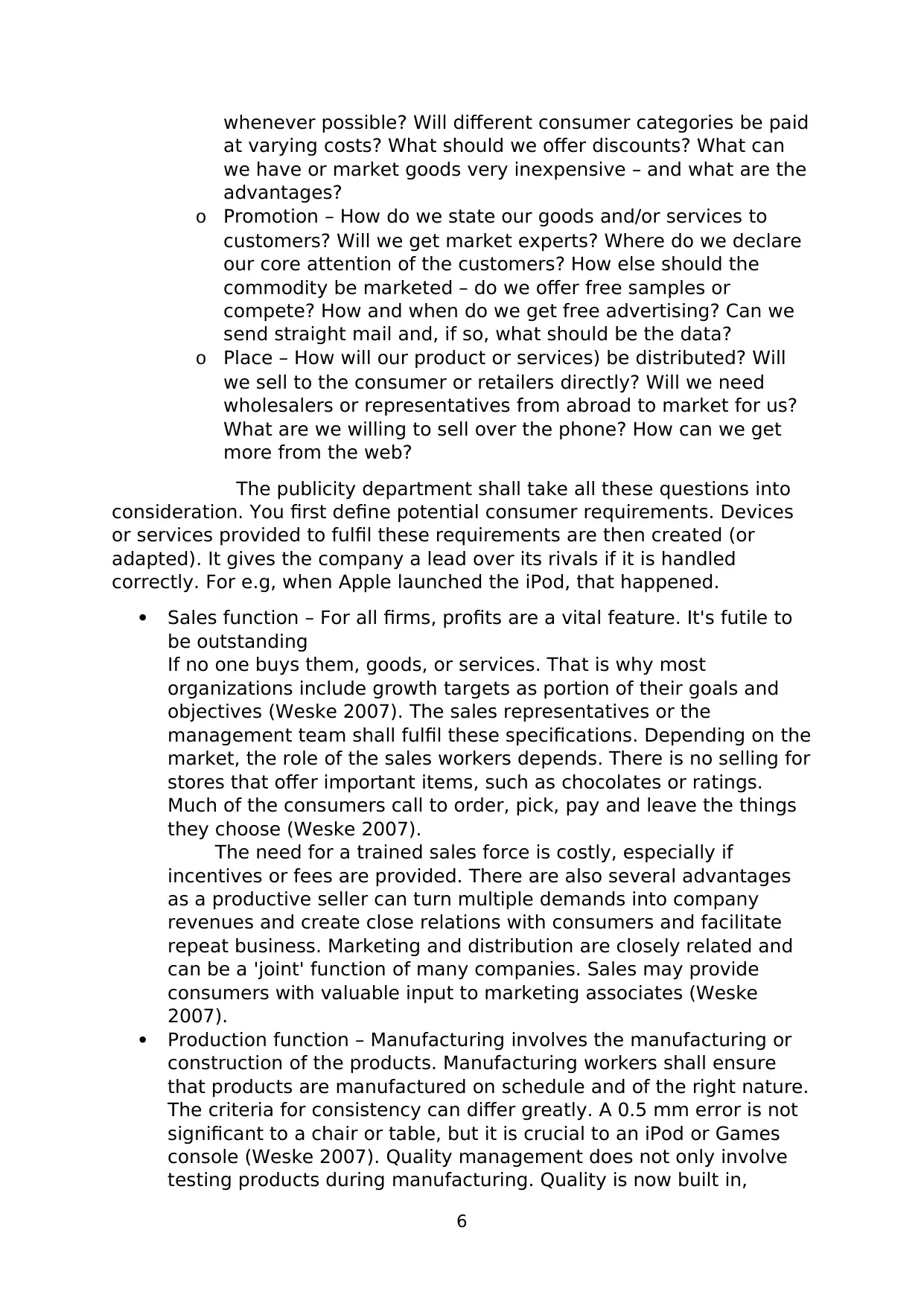
whenever possible? Will different consumer categories be paid
at varying costs? What should we offer discounts? What can
we have or market goods very inexpensive – and what are the
advantages?
o Promotion – How do we state our goods and/or services to
customers? Will we get market experts? Where do we declare
our core attention of the customers? How else should the
commodity be marketed – do we offer free samples or
compete? How and when do we get free advertising? Can we
send straight mail and, if so, what should be the data?
o Place – How will our product or services) be distributed? Will
we sell to the consumer or retailers directly? Will we need
wholesalers or representatives from abroad to market for us?
What are we willing to sell over the phone? How can we get
more from the web?
The publicity department shall take all these questions into
consideration. You first define potential consumer requirements. Devices
or services provided to fulfil these requirements are then created (or
adapted). It gives the company a lead over its rivals if it is handled
correctly. For e.g, when Apple launched the iPod, that happened.
Sales function – For all firms, profits are a vital feature. It's futile to
be outstanding
If no one buys them, goods, or services. That is why most
organizations include growth targets as portion of their goals and
objectives (Weske 2007). The sales representatives or the
management team shall fulfil these specifications. Depending on the
market, the role of the sales workers depends. There is no selling for
stores that offer important items, such as chocolates or ratings.
Much of the consumers call to order, pick, pay and leave the things
they choose (Weske 2007).
The need for a trained sales force is costly, especially if
incentives or fees are provided. There are also several advantages
as a productive seller can turn multiple demands into company
revenues and create close relations with consumers and facilitate
repeat business. Marketing and distribution are closely related and
can be a 'joint' function of many companies. Sales may provide
consumers with valuable input to marketing associates (Weske
2007).
Production function – Manufacturing involves the manufacturing or
construction of the products. Manufacturing workers shall ensure
that products are manufactured on schedule and of the right nature.
The criteria for consistency can differ greatly. A 0.5 mm error is not
significant to a chair or table, but it is crucial to an iPod or Games
console (Weske 2007). Quality management does not only involve
testing products during manufacturing. Quality is now built in,
6
at varying costs? What should we offer discounts? What can
we have or market goods very inexpensive – and what are the
advantages?
o Promotion – How do we state our goods and/or services to
customers? Will we get market experts? Where do we declare
our core attention of the customers? How else should the
commodity be marketed – do we offer free samples or
compete? How and when do we get free advertising? Can we
send straight mail and, if so, what should be the data?
o Place – How will our product or services) be distributed? Will
we sell to the consumer or retailers directly? Will we need
wholesalers or representatives from abroad to market for us?
What are we willing to sell over the phone? How can we get
more from the web?
The publicity department shall take all these questions into
consideration. You first define potential consumer requirements. Devices
or services provided to fulfil these requirements are then created (or
adapted). It gives the company a lead over its rivals if it is handled
correctly. For e.g, when Apple launched the iPod, that happened.
Sales function – For all firms, profits are a vital feature. It's futile to
be outstanding
If no one buys them, goods, or services. That is why most
organizations include growth targets as portion of their goals and
objectives (Weske 2007). The sales representatives or the
management team shall fulfil these specifications. Depending on the
market, the role of the sales workers depends. There is no selling for
stores that offer important items, such as chocolates or ratings.
Much of the consumers call to order, pick, pay and leave the things
they choose (Weske 2007).
The need for a trained sales force is costly, especially if
incentives or fees are provided. There are also several advantages
as a productive seller can turn multiple demands into company
revenues and create close relations with consumers and facilitate
repeat business. Marketing and distribution are closely related and
can be a 'joint' function of many companies. Sales may provide
consumers with valuable input to marketing associates (Weske
2007).
Production function – Manufacturing involves the manufacturing or
construction of the products. Manufacturing workers shall ensure
that products are manufactured on schedule and of the right nature.
The criteria for consistency can differ greatly. A 0.5 mm error is not
significant to a chair or table, but it is crucial to an iPod or Games
console (Weske 2007). Quality management does not only involve
testing products during manufacturing. Quality is now built in,
6
⊘ This is a preview!⊘
Do you want full access?
Subscribe today to unlock all pages.

Trusted by 1+ million students worldwide
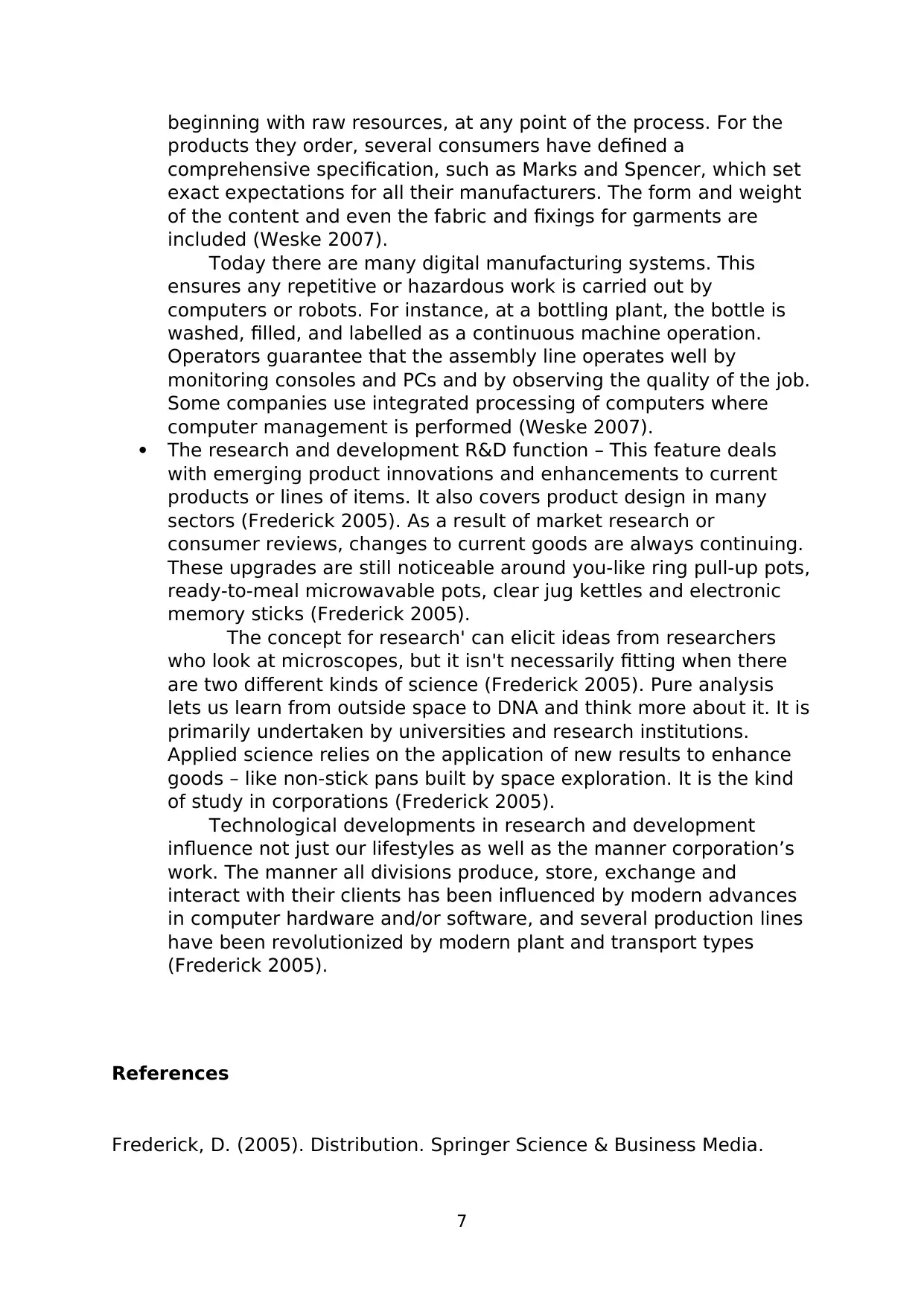
beginning with raw resources, at any point of the process. For the
products they order, several consumers have defined a
comprehensive specification, such as Marks and Spencer, which set
exact expectations for all their manufacturers. The form and weight
of the content and even the fabric and fixings for garments are
included (Weske 2007).
Today there are many digital manufacturing systems. This
ensures any repetitive or hazardous work is carried out by
computers or robots. For instance, at a bottling plant, the bottle is
washed, filled, and labelled as a continuous machine operation.
Operators guarantee that the assembly line operates well by
monitoring consoles and PCs and by observing the quality of the job.
Some companies use integrated processing of computers where
computer management is performed (Weske 2007).
The research and development R&D function – This feature deals
with emerging product innovations and enhancements to current
products or lines of items. It also covers product design in many
sectors (Frederick 2005). As a result of market research or
consumer reviews, changes to current goods are always continuing.
These upgrades are still noticeable around you-like ring pull-up pots,
ready-to-meal microwavable pots, clear jug kettles and electronic
memory sticks (Frederick 2005).
The concept for research' can elicit ideas from researchers
who look at microscopes, but it isn't necessarily fitting when there
are two different kinds of science (Frederick 2005). Pure analysis
lets us learn from outside space to DNA and think more about it. It is
primarily undertaken by universities and research institutions.
Applied science relies on the application of new results to enhance
goods – like non-stick pans built by space exploration. It is the kind
of study in corporations (Frederick 2005).
Technological developments in research and development
influence not just our lifestyles as well as the manner corporation’s
work. The manner all divisions produce, store, exchange and
interact with their clients has been influenced by modern advances
in computer hardware and/or software, and several production lines
have been revolutionized by modern plant and transport types
(Frederick 2005).
References
Frederick, D. (2005). Distribution. Springer Science & Business Media.
7
products they order, several consumers have defined a
comprehensive specification, such as Marks and Spencer, which set
exact expectations for all their manufacturers. The form and weight
of the content and even the fabric and fixings for garments are
included (Weske 2007).
Today there are many digital manufacturing systems. This
ensures any repetitive or hazardous work is carried out by
computers or robots. For instance, at a bottling plant, the bottle is
washed, filled, and labelled as a continuous machine operation.
Operators guarantee that the assembly line operates well by
monitoring consoles and PCs and by observing the quality of the job.
Some companies use integrated processing of computers where
computer management is performed (Weske 2007).
The research and development R&D function – This feature deals
with emerging product innovations and enhancements to current
products or lines of items. It also covers product design in many
sectors (Frederick 2005). As a result of market research or
consumer reviews, changes to current goods are always continuing.
These upgrades are still noticeable around you-like ring pull-up pots,
ready-to-meal microwavable pots, clear jug kettles and electronic
memory sticks (Frederick 2005).
The concept for research' can elicit ideas from researchers
who look at microscopes, but it isn't necessarily fitting when there
are two different kinds of science (Frederick 2005). Pure analysis
lets us learn from outside space to DNA and think more about it. It is
primarily undertaken by universities and research institutions.
Applied science relies on the application of new results to enhance
goods – like non-stick pans built by space exploration. It is the kind
of study in corporations (Frederick 2005).
Technological developments in research and development
influence not just our lifestyles as well as the manner corporation’s
work. The manner all divisions produce, store, exchange and
interact with their clients has been influenced by modern advances
in computer hardware and/or software, and several production lines
have been revolutionized by modern plant and transport types
(Frederick 2005).
References
Frederick, D. (2005). Distribution. Springer Science & Business Media.
7
1 out of 7
Your All-in-One AI-Powered Toolkit for Academic Success.
+13062052269
info@desklib.com
Available 24*7 on WhatsApp / Email
![[object Object]](/_next/static/media/star-bottom.7253800d.svg)
Unlock your academic potential
Copyright © 2020–2025 A2Z Services. All Rights Reserved. Developed and managed by ZUCOL.